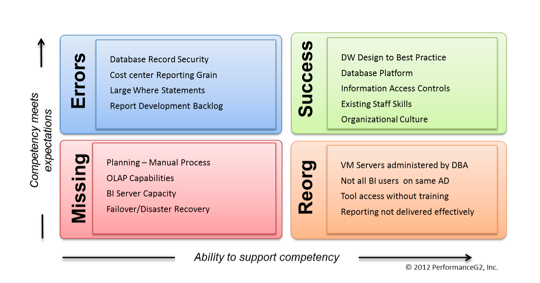Gartner defines business intelligence (BI) as an umbrella term spanning the people, processes and applications used to organize information, enable access to it, and analyze it to improve decisions and management performance. Conversely, many organizations are often focused on reporting and not decision support – all while management asks for decision support solutions such as interactive dashboards. What if the delivered dashboards and the operational reports are not linked through common key performance indicators? One end result of this practice is ineffective, reactive, and cost prohibitive decision-making. An effective BI solution, when implemented under guidance from Gartner’s definition of BI, will allow an organization to cut costs and compete more effectively by enabling better business outcomes through more proactive decision-making.
What if an organization is only focused on report management? Is this a poor practice? Not if done properly, as report management is the evolutionary foundation for BI driven decision support. Proper reporting means the output must be effective and actionable to add value to the organization. What if the reports deliver unorganized lists of data and these lists are provided in an ineffective medium? Users will inevitably extract and summarize or even scan through these lists of data to produce information. What if the information outcomes are not aligned with the business objectives of the organization? In these cases, information becomes a hindrance, adding cost and time to account for shortcomings in standardized meaningful information delivery and usage. A model BI solution is aligned with pre-defined organizational business objectives and deliverers trusted targeted actionable information to the right users at the right time in the right medium, not lists of data. So, how does an organization map a strategy to accomplish this?
A proven approach is to build a performance management BI roadmap. The roadmap engagement starts with gap assessment used to evaluate the current state and the desired state information and infrastructure needs for the organization. This gap analysis is subsequently aligned with the identified, documented, and confirmed organizational business objectives. Finally, this information is used to architect eloquent BI solutions supporting business objectives based on the desired state of BI. The BI solutions could range anywhere from actionable managed reports to comprehensive balanced scorecards. The resulting roadmap is a strategy meant to guide an organization in creating business objective aligned proactive, actionable, and effective information driven BI solutions.
The image below is a sample of PerformanceG2’s information / infrastructure current state to desired state gap matrix resulting from our in-depth gap analysis. In practice, there are two different matrices developed, one for business information and one for people, process, and technical infrastructure. The gaps are determined as a part of technical and business related interviews conducted during a roadmap exercise. We use this and other industry proven applications to develop the comprehensive roadmap.
Tune in next week for Part II of the Roadmap series blog, to learn the elements of a successfully built roadmap.


